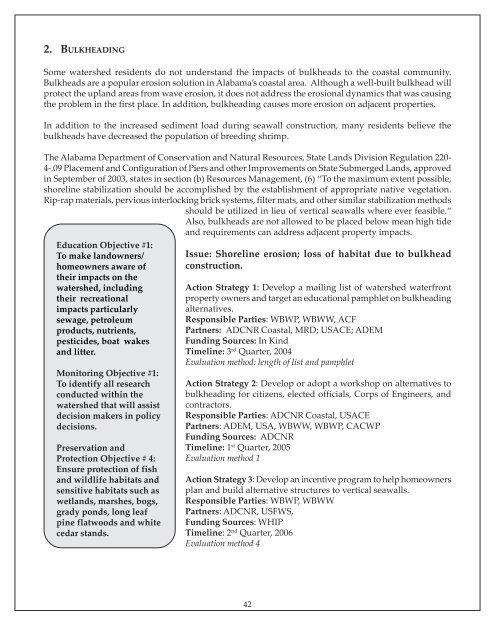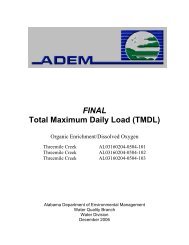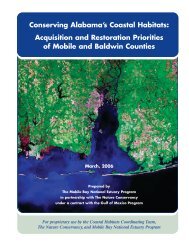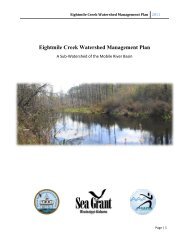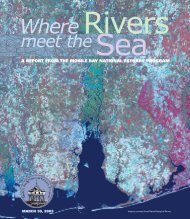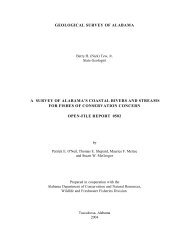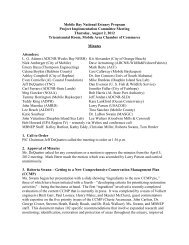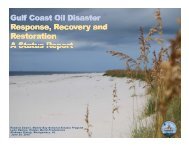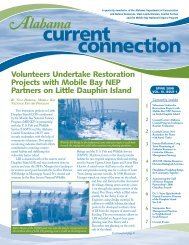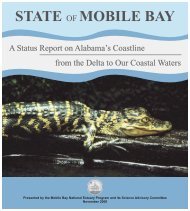Wolf Bay Plan Final - Mobile Bay National Estuary Program
Wolf Bay Plan Final - Mobile Bay National Estuary Program
Wolf Bay Plan Final - Mobile Bay National Estuary Program
- No tags were found...
You also want an ePaper? Increase the reach of your titles
YUMPU automatically turns print PDFs into web optimized ePapers that Google loves.
2. BULKHEADINGSome watershed residents do not understand the impacts of bulkheads to the coastal community.Bulkheads are a popular erosion solution in Alabama’s coastal area. Although a well-built bulkhead willprotect the upland areas from wave erosion, it does not address the erosional dynamics that was causingthe problem in the first place. In addition, bulkheading causes more erosion on adjacent properties.In addition to the increased sediment load during seawall construction, many residents believe thebulkheads have decreased the population of breeding shrimp.The Alabama Department of Conservation and Natural Resources, State Lands Division Regulation 220-4-.09 Placement and Configuration of Piers and other Improvements on State Submerged Lands, approvedin September of 2003, states in section (b) Resources Management, (6) “To the maximum extent possible,shoreline stabilization should be accomplished by the establishment of appropriate native vegetation.Rip-rap materials, pervious interlocking brick systems, filter mats, and other similar stabilization methodsshould be utilized in lieu of vertical seawalls where ever feasible.“Also, bulkheads are not allowed to be placed below mean high tideand requirements can address adjacent property impacts.Education Objective #1:To make landowners/homeowners aware oftheir impacts on thewatershed, includingtheir recreationalimpacts particularlysewage, petroleumproducts, nutrients,pesticides, boat wakesand litter.Monitoring Objective #1:To identify all researchconducted within thewatershed that will assistdecision makers in policydecisions.Preservation andProtection Objective # 4:Ensure protection of fishand wildlife habitats andsensitive habitats such aswetlands, marshes, bogs,grady ponds, long leafpine flatwoods and whitecedar stands.Issue: Shoreline erosion; loss of habitat due to bulkheadconstruction.Action Strategy 1: Develop a mailing list of watershed waterfrontproperty owners and target an educational pamphlet on bulkheadingalternatives.Responsible Parties: WBWP, WBWW, ACFPartners: ADCNR Coastal, MRD; USACE; ADEMFunding Sources: In KindTimeline: 3 rd Quarter, 2004Evaluation method: length of list and pamphletAction Strategy 2: Develop or adopt a workshop on alternatives tobulkheading for citizens, elected officials, Corps of Engineers, andcontractors.Responsible Parties: ADCNR Coastal, USACEPartners: ADEM, USA, WBWW, WBWP, CACWPFunding Sources: ADCNRTimeline: 1 st Quarter, 2005Evaluation method 1Action Strategy 3: Develop an incentive program to help homeownersplan and build alternative structures to vertical seawalls.Responsible Parties: WBWP, WBWWPartners: ADCNR, USFWS,Funding Sources: WHIPTimeline: 2 nd Quarter, 2006Evaluation method 442


